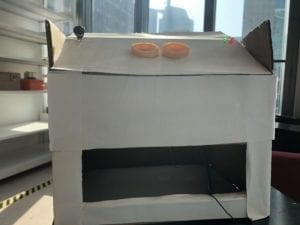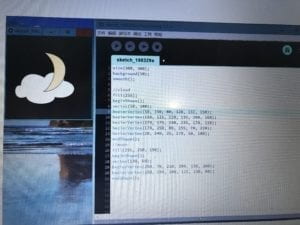This is my midterm project blog post.
- Context and Significance : Before we decided on what to make, we browsed on the Internet to see what possibly we can make, for we only get limited mterials and limited ability of programming. We have one specific criteria in mind that is, our project needs to be fun and interactive, and we came to the “buzz wire” game, in which the player has to move a conductive handle across a copper wire and try not to let them touch each other. It’s an interesting game and it’s interactive and challenging, thus we decided to take it as a inspiration of our own making. The interactive elements in the game are quite visualized, there are lights on to inform the user that they touch the wire once, and through the whole process the user is making his own efforts to actually interact with the device. The target of our project can be anyone who wants to take a challenge on completing the game.
- Conseption and Design: We decided to follow some parts of the original interactive elements from the “buzz wire” game. We built a box and put the whole game inside, and we used LED lights and put them in visible place so that the users can know how many time they have touch the wire. One fun aspect we add to the game is that we didn’t let the whole game comletely exposed to the player, instead, we design two peep holes on the top of the box., which add more fun to the game and make it more challenging. We recieved many useful feedbacks from the user test session, which enable us to improve the design of the box, for example, the box was made from paper board, which made it not so stable, thus we rearrange the position of the components and made it more stable.
- Fabrication and Production: As I just mentioned , in the user test session we received lots of feedbacks and they gave us valuable information to make our box better. For our design of the peep holes, people generally like it but some says it’s hard for user to sense the depth and thus makes it very difficult ot control the handle. They suggested us to remove the peep holes design and replace it with broader peeping window. We didn’t take that decision but we did make changes to the wire it self, making it not so curved ; we also change the position of the LED inside, moving it to a place that is visible to the users when looking through the peep holes. We also added a reset button that enable the user to reset for themselves, since we found that it’s always annoying to reset through Arduino and reduce the possibility of touching the wire before the user started. We used 3D printing for the peep holes, making them into two seperate cylinders.
4. Conclusions: The goal of our project is to let uses experience the interacton with the game through the support of Arduino. Both during the user test session and the presentation our project had successfully lots of people that want to take a try, which inspired us a lot. Though there are still flaws of our project, I’d say it has met with our expectation of being both interactive and entertaining. The value of making this project is significant, for this is my first time conducitng a device without any instructions, we met lots of barriers during the process, however, through our joint efforts, we did it. We gained experience on seraching for informations, designing the project, processing users’ feedback and making changes to both physical design and coding programs. It’d a great lesson for me. If we had more time, we would possibly improve the interactive part, add more elements to it such as sounds and visualized numbers, which could create a better interactive experience for users.









